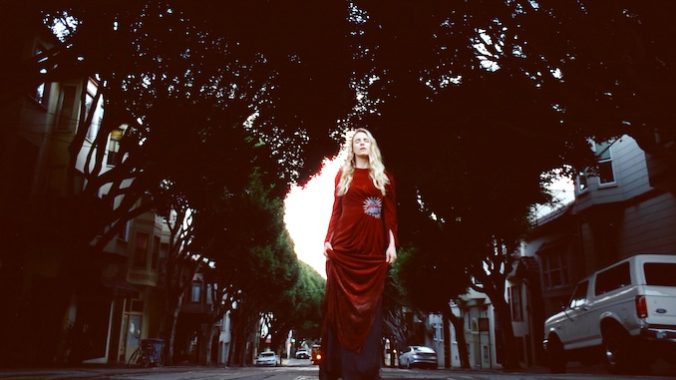TV Rewind: It’s a Miracle The OA Was Ever Allowed To Exist at All
Photo Courtesy of Netflix
Editor’s Note: Welcome to our TV Rewind column! The Paste writers are diving into the streaming catalogue to discuss some of our favorite classic series as well as great shows we’re watching for the first time. Come relive your TV past with us, or discover what should be your next binge watch below:

Four years after Netflix’s The OA was unceremoniously canceled after two seasons (following arguably the most meta finale ever), I’m still caught between half-expecting it to return, and half-believing it was all a dream. Such was The OA‘s magic, which earnestly beseeched both its characters and its audience to believe impossible things. It must have worked on Netflix, too, because that’s the only explanation I can come up with for why the short-lived series was allowed to exist at all. Maybe, for a time, the powers-that-be were just as enthralled with co-creators Brit Marling (who also starred as the titular “Original Angel,” or OA) and Zal Batmanglij’s bizarre appeal to faith, imagination, and the power of artistic expression as the OA’s devoted acolytes.
Now with Marling and Batmanglij returning to television with their new series, A Murder at the End of the World, the beautiful anomaly that was The OA, and how surprising it is that it ever existed at all, is top of mind.
From the jump, The OA felt like an underdog. That the trailer appeared out of nowhere less than a week before the show premiered—dropping onto YouTube December 12, 2016, four days before release—wasn’t exactly unusual, but hardly seemed to bode well for the series’ success. And that dollop of marketing didn’t even give a very clear indication of what the show would be about. It seemed to promise a story about a woman who disappeared as a child and returned years later, now with her vision restored after previously being blind. But otherwise, it was hard to tell what to expect. Was it sci-fi? Family drama? A poignant exploration of trauma and recovery?
Then the show hit Netflix, and it quickly became clear that it was all of the above, and also unlike anything we had ever seen. From the very first episode, The OA defied expectations, taking nearly an hour to get around to the opening credits (after taking a hard pivot into a backstory literally no one, including the characters on the screen, saw coming) and keeping us on our toes for everything that followed.
Part-abduction thriller, part-supernatural fantasy, part-cerebral sci-fi, and part, um, heartwarming cult origin story(?), The OA follows Marling’s protagonist, who was abducted as a blind young woman named Prairie Johnson, and returns seven years later as a sighted oracle who calls herself “the OA.” In the first episode, she recruits a group of four high school students and one lonely teacher to join her in an abandoned construction site, where she spends each evening telling them her mind-boggling life story, including how she spent the past seven years held prisoner by the villainous Hap (Jason Isaacs), who subjected her and her fellow prisoners to repeated near-death experiences in the hopes of discovering a portal to another dimension.
And that’s where the show gets truly weird: the OA believes Hap’s experiments worked. She thinks she has learned how to access another dimension, and that she can use it to rescue the others, who are still trapped in Hap’s basement dungeon. But she’s going to need some help, which is where her five new acolytes come in. Because the key to opening the portal relies on all of them performing “The Movements,” a sequence of divinely choreographed dance moves, in perfect unison and with utter sincerity. When executed correctly, The Movements have the power to heal the sick, raise the dead, and even send the performers to another dimension.
Yes, The OA argues that the secret to unlocking ultimate, cosmic power is dance. But just wait, it gets stranger. By the end of the second season—which brings in a secret alt-universe dream lab, a psychic octopus, puzzle houses, and dancing robots—viewers had followed the show through so many twists and turns that The Movements felt almost old hat. And by the close of the finale, which broke the fourth wall so thoroughly it may as well have been vaporized, it was easy to believe in impossible things.
Spoilers, I guess, except I’m not sure it’s possible to spoil the experience of The OA with just a few sentences. Kind of like a roller coaster, it’s one thing to talk about The OA, but another thing entirely to climb aboard. Maybe that’s why Netflix signed on in the first place. Maybe they thought they knew what they were getting into after viewing Marling’s previous writing projects, including the films Sound of My Voice, Another Earth, and The East. After all, they too explored themes of alternate realities, the power (for better or worse) of groupthink, and the nature of belief. It would have been reasonable to assume that The OA might be along the same lines. And it was, at first. At least a little bit. At least for a while.
In hindsight, it boggles the mind that we got even one season of this genre-defying, mind-bending, defiantly optimistic show, let alone two, once it became clear what it was.
-

-

-

-

-

-

-

-

-

-

-

-

-

-

-

-

-

-

-

-

-

-

-

-

-

-

-

-

-

-

-

-

-

-

-

-

-

-

-

-








































